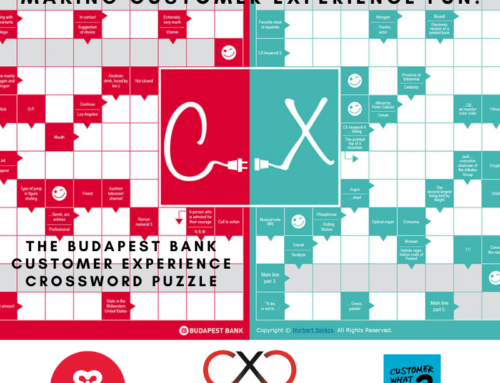
The whole idea of the Net Promoter Score (NPS) is based around asking customers the question ‘How likely is it that you would recommend our company/product/service to a friend or colleague?’ and proposing to them a variety of response options based on a zero to ten scale. In the years since its introduction, NPS has become used all over the world and few organisations fail to ask their customers this question in one form or another at some point in the organisation/customer interaction.
Yet how useful is NPS really, unaided by any other metric, as an effective way of assessing an organisation’s appeal to its customers?
My own thinking and experience is that today, especially in an epoch when social media allows customers to indicate pretty much instantly how they feel about an organisation, a business which wants its customers to love it needs to do far more than just measure NPS.
The main reason why NPS is only a metric of limited utility is that it doesn’t give any definite understanding of the extent to which an organisation is meeting customer needs, and more importantly which ones it is not meeting.
This is not to say that NPS has no value, of course it does, but more as a kind of quick barometric reading giving an assessment of how an organisation is doing in relation to its customers, rather than anything deeper.
In practice, NPS is more commonly used by marketing departments than operations departments. After all, the job of the marketing department is to focus on creating the best image of the organisation’s brand now and going forward.
It’s not surprising that a metric (NPS) which focuses on the likelihood of customers to promote the brand to others (assuming they make such recommendations at all) sits most comfortably with the organisation’s brand promoters.
However, the operations department may not find customers’ promotional propensity particularly helpful. The ops department’s job is to focus on the day-to-day operations in the here and now and for that it needs to know as much as it can about its customers’ needs and wants and to what extent it is delivering on them in its everyday activities.
Let’s bring some useful and indeed essential definitions into focus:
Customer needs can be defined as the benefits the customer absolutely must be getting from the organisation if that organisation is going to be successfully in business at all.
Customer wants, on the other hand, are benefits that will enhance the experience but are not fundamental needs. Customers of an airline, for example, need a seat in an airplane that will take them safely to their destination on time. A haute cuisine meal on the flight, by contrast, is a want, not a need.
Identifying specific customer needs and wants is extremely difficult to achieve through NPS, for the simple enough reason that these are not what NPS measures.
Much of my work over the past ten years has been directed at trying to develop a metric that can in effect complement NPS and provide organisations with the level of insight they need about how they are meeting customer needs in the here and now and that can be acted upon where required.
I’m not of course suggesting NPS should be discarded. NPS ought to be seen as a measurement to which specific insights about how an organisation is meeting customer needs and nice-to-haves must be added.
Through more than a decade of practical work with my own clients, and discussing in detail their own needs for a metric to assess how their business is doing and of course discussing how useful or otherwise NPS is to them, I’ve come up with a completely new metric. I call this the Net Customer Need Score, or NetCNS for short.
The genesis of the NetCNS is that for CEOs, COOs, customer experience directors, sales directors and most other people in a senior organisational position, there should be only one question in their minds about customer experience. This question is: How are we meeting our customers’ needs on a day-by-day, week-by-week and month-by-month basis?
NetCNS has been designed to deliver just one number that provides an organisation-wide operational measure and benchmark for how customer needs are being met and also to provide a deeper understanding of the needs that actually drive the score in the first place. In doing so, the organisation benefits from a clear indication of what it must do now in order to meet its customers’ needs more effectively and meet as many of its customers’ wants/nice-to-haves as it can do profitably. These indications can then be acted upon pretty much instantly by staff on the front line, driving up the number of customer needs that are met successfully.
So a useful way to describe NetCNS is to say that NetCNS is to operations what NPS is to marketing.
Indeed, it may be argued that NetCNS is in fact the best predictor of NPS. After all, as a matter of logic and commercial common-sense, how could a customer reasonably recommend a service, brand or experience, if their basic needs are not being met?
How does the NetCNS actually work at a practical level?

To arrive at an organisation’s NetCNS you need to proceed through the above straightforward three-step process. It works as follows:
- Customer Needs – The best way to work out exactly what customer needs are, is to listen carefully and understand the feedback provided by your customers. Most organisations already have significant quantities of text, verbal and other verbatim data so it is a relatively straightforward matter to identify themes and group the feedback in a way that describe needs and wants. Often common groups of needs emerge from this feedback, however their priority and specific mix will vary from organisation to organisation, across different sectors.
- Customer Needs Score – Having established what the customer needs are, each customer’s verbatim statements can be scored by them through traditional surveys, face-to-face workshops or online data capture to indicate how well a customer need is met across three different dimensions:
a) Emotion – how do customers feel when the need is not meet?
b) Importance – how important is the need?
c) Performance – how well does the organisation currently meet that need?
- The Customer Needs Score (CNS) can be calculated by establishing a weighted formula that represents a sum of the experience that relates to the need they have specified and if that need has been met or not.
- Calculating Net Customer Need Score (NetCNS) – The NetCNS is obtained in the same way that the NPS is, by totaling the number of Customer needs that have been met, then taking away the number that have not been met. This is then divided by the number of responses and multiplied x100 to produce a score between -100 and +100. This number is the NetCNS for the organisation.
So, like NPS, the NetCNS delivers a numerical score (between -100 and +100). However, additionally and, most importantly to calculate NetCNS you must have first understood your customer needs and wants and how each grouping is performing. This means that when the Board asks – why has the score moved? – you already know the answer.
Organisations that combine use of NetCNS with the NPS metric will give themselves the best opportunity to maximise their competitive edge, now and in the future. They will also create an understanding for themselves of what they must deliver to meet their customers’ needs and also those customer wants that can be delivered profitably or at minimum cost. So I offer the NetCNS thinking and concept freely to anyone who truly cares about their customers and wants to maximise the competitive edge gained from keeping customers happy and eager to come back for more.

With more than thirty years’ experience in customer service, retail and consultancy, Stephen Hewett is one of the UK’s leading authorities and business advisors in the field of customer centred business change. He co-founded the UK based international organisation iCustomer, which helps its clients capture, identify, understand and measure its customer needs and wants in order to create successful organisations that are loved by their customers through the application of the NetCNS System, a methodology and software solution that delivers improved NetCNS.






Interesting concept. A key challenge is in the analysis of the verbatim responses. Many companies have volumes of NPS “Why?” and “What should we improve?” responses that are far more than humans can possibly understand. Software to do it in a fully-automated way is still in its infancy. Still, let’s suppose a combination of human and machine intelligence can boil down all the input to two or three key improvement opportunities, whether they be for ‘wants’ or ‘needs’. Assessing the impact and progress of each of these seems useful.
The ‘boiling down’ process is difficult. I suspect that 30,000 verbatim responses could give you 500 different needs and wants. Do they all enter into the metric? If not, what would be the logic for discarding them without extensive evaluation of each?
Hello Maurice – thank you for your comment. Yes, your thinking and understanding is entirely correct in that:
Understanding the context of how the verbatim is captured is vital. Experience shows that not all verbatims are equal.
After lots of experimentation, we have found that the use of Saturation Theory, which allows for smaller sample sizes combined with the Mark One human brain, allows for the codification of a manageable set of customer needs groups.
Iteration and further coding using the ‘examples’ created can then be achieved using an appropriately configured machine learning approach to code large amounts of verbatims.
I would be very happy to discuss further if that would interest you.
In the last 10 years, how often have you used this metric in practice? What challenges have you seen with it? Do board members challenge the new metric?
Also, I’m confused about implementing this… 1) Are you suggesting this is a follow up to NPS (adding an additional customer touchpoint)? Where you analyze NPS comments into categories, send a second survey asking your three questions about Emotion, Importance, and Performance for EACH of the Categories? Or 2) in your NPS survey add these questions after an open comment field to try and get how they feel about what they just commented on? or 3) something else?
Hi Tiffany – Thank you for taking the time to leave a comment.
The metric is brand new and is currently being tested by 3 large organisations here in the UK. One is a national retailer, the others are an insurance company and a charity. So far we have had very positive feedback from CXO and Boards about the metric, because I think it makes sense and addresses a simple concept.
On your second question, the approach is to ask customers for feedback about what they need & want from an organisation. Where a need is defined as something, that if it is not there or met the customer would perceive that the service or brand was failing. Once they have provided the feedback you can then ask them to score emotion, importance and performance connect to the feedback they have provided. One of the trial organisations has added the questions to a standard NPS feedback survey as an addition verbatim feedback field followed by the score questions.
Collecting enough verbatims and grouping them into needs & wants allows you to calculate a NetCNS score and understand which needs & wants have the most impact on the organisational score. This means that you can quickly identify areas of underperformance and take action to correct it.
I hope that helps, but do feel free to come back to me if you need any further information.
This is fascinating! Can you share how this information is reported out in an Executive Summary or Survey report? Also, I would love to see a YouTube video about this new metric and how it is put into practice.
P.S. Or a webinar 🙂